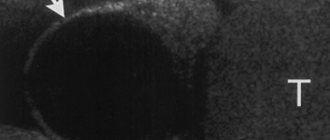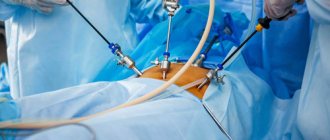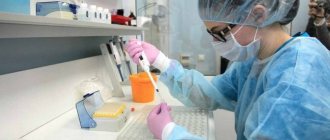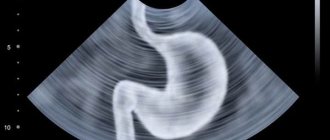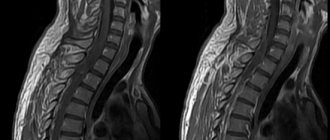Echohysterosalpingography or hydrosonography is a highly informative method for diagnosing the patency of the fallopian tubes using ultrasound and a contrast agent. This procedure allows you to identify pathologies that prevent the conception of a child. A more common name for this procedure is ultrasound of fallopian tube patency.
- Features of ultrasound examination of fallopian tube patency
- Indications and contraindications for ultrasound of the fallopian tubes
- Is preparation necessary for an ultrasound examination of fallopian tube patency?
- How is ultrasound examination of fallopian tube patency performed?
- Advantages and disadvantages of the ultrasound method
Indications and contraindications for hysterosalpingography
Typically, an examination is prescribed to diagnose the causes of infertility.
An HSG can be done in a clinic, having previously received a referral from a gynecologist. Typically, an examination is prescribed to diagnose the causes of infertility. The procedure is performed if, in the absence of contraception, a woman under 35 years of age for a year or over 35 years of age for six months cannot become pregnant.
Diagnostics is also necessary if you suspect:
- disorders of the anatomical structure of the uterus and appendages
- fibroids
- adhesions
- polyps and other pathologies
Indications for fallopian tube HSG are determined by the doctor as part of a survey and examination of the patient, as well as after other examinations.
In some cases, no diagnosis is made.
The procedure should be postponed if:
- Pregnancy. It is necessary to limit sexual contact or use contraception for a month before the procedure
- Allergies to contrast agents. During diagnosis, iodine-containing substances are used. They can provoke an acute reaction from the woman’s body
- Bacterial and infectious diseases
- Inflammatory processes (especially in the acute stage)

The final decision on the advisability of fallopian tube HSG is made by the doctor. This allows the procedure to be as safe as possible.
Diagnosis is also refused for uterine bleeding, thrombophlebitis and some other pathologies.
Important! The final decision on the advisability of fallopian tube HSG is made by the doctor. This allows the procedure to be as safe as possible.
How to prepare?
Preparation for the examination largely determines its informativeness and effectiveness. That is why a woman needs to strictly follow the recommendations given by the doctor.

Since the HSG procedure of the fallopian tubes has a number of contraindications, you should make sure that there are none.
As part of your preparation you should:
- Stop using vaginal tablets, suppositories and sprays for a week
- During the procedure, use contraception or refuse sexual intercourse to prevent the possibility of conception
Hygiene procedures should be carried out several hours before diagnosis. The study has nothing to do with food intake, so you should not limit yourself in food.
Since the HSG procedure of the fallopian tubes has a number of contraindications, you should make sure that there are none. To do this, the patient undergoes some tests.
Typically, a set of studies includes:
- Blood test for HIV, hepatitis and syphilis
- Flora smear
The exact list of studies will be announced by the doctor. In some cases, a preliminary ultrasound of the pelvic organs is performed.
On what day of the cycle is HSG performed?
The best period for hysterosalpingography is the period between menstruation and ovulation. Typically, the examination is carried out on days 7-12 of the cycle.

The best period for hysterosalpingography is the period between menstruation and ovulation. Typically, the examination is carried out on days 7-12 of the cycle.
When you can and should perform an HSG, your gynecologist will tell you. He will select the optimal day for diagnostics and answer all questions in advance. This will allow you to properly prepare for the examination and increase its accuracy.
Preparation
Given that most procedures are not simple, they require appropriate preparation on the part of the patient, especially if the use of general anesthesia is envisaged.
The most important points remain:
- Complete preliminary examination (consultation with a doctor and passing all tests).
- 2 days before almost all procedures, you need to abstain from sexual intercourse. The doctor may stop taking certain medications if they affect the final result.
- A week before the relevant procedure, you should stop using vaginal suppositories, douching, and the like.
Thus, it will be possible to obtain the most reliable results of any of the above examinations. You can do sonohysterosalpingoscopy at the AltraVita clinic. Here the examination will be as safe and comfortable as possible for the patient. Our specialists use cutting-edge diagnostic equipment and have extensive experience in this field, which allows us to achieve highly accurate research results.
How is the HSG procedure performed?
The examination is carried out in a specially equipped room. The room is equipped not only with a gynecological chair, but also with an X-ray machine.
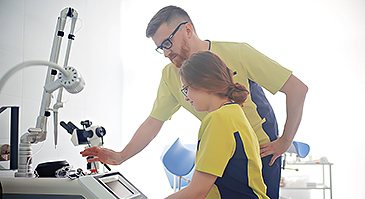
The examination is carried out in a specially equipped room. The room is equipped not only with a gynecological chair, but also with an X-ray machine.
The HSG procedure of the fallopian tubes, like any other in medicine, is carried out in several stages:
- The patient is positioned on the x-ray table
- The doctor inserts gynecological speculum into the vagina and carries out antiseptic treatment
- A special catheter is inserted into the cervical canal, through which a contrast agent is supplied to the uterine cavity.
- After the uterus fills with fluid, the doctor takes pictures and monitors the passage of contrast through the fallopian tubes
This completes the procedure. The doctor begins to evaluate the results obtained.
As part of the diagnosis, a woman may experience slight discomfort. Immediately after the examination, the patient can go home or return to her usual activities.
After HSG, the following are possible:
- small discharge (sacral) from the genital tract, lasting a maximum of 2-3 days
- slight nausea
- pulling sensations in the lower abdomen, comparable to painful menstruation
- slight weakness and dizziness
These side effects are normal. They are provoked by the intervention, but are not dangerous to the health and life of the woman. To eliminate discomfort, the patient may be recommended special medications for pain relief and spasm relief.

To eliminate discomfort, the patient may be recommended special medications for pain relief and spasm relief.
Important! Medicines are prescribed exclusively by a doctor.
Also, in the first few days after the HSG procedure of the fallopian tubes, you should refrain from physical activity and sexual intercourse, as well as from visiting the bath, bathhouse and sauna.
Important! If the temperature rises, bleeding increases or other side effects occur, you should immediately seek medical help!
Methods for determining the patency of the fallopian tubes in women
X-ray examination (hysterosalpingography)
This method of checking the patency of the fallopian tubes involves the introduction of a special water-soluble iodine-containing substance, which is contrasting for x-rays, into the uterine cavity and the subsequent taking of a series of photographs. By assessing them, the doctor can determine how the contrast is distributed in the pelvic cavity. All solutions used contain iodine. For this reason, the procedure is carried out only if there is no allergy to it.
This method of checking the patency of the fallopian tubes involves the introduction of a special water-soluble iodine-containing substance, which is contrasting for x-rays, into the uterine cavity and the subsequent taking of a series of photographs.
The technique of performing hysterosalpingography is quite simple for an experienced doctor. A thin catheter is inserted into the cervical canal, through which a small amount of contrast agent enters the uterine cavity. An x-ray is then taken. After this, some more contrast is injected. The photo is taken again. On it, the doctor sees the uterine cavity and fallopian tubes filled with a special substance. Based on the shape of the organs, their filling, and the location of the contrast in the small pelvis, a specialist can identify adhesions.
The procedure takes about 30 minutes and is performed without anesthesia. Its main advantages include high accuracy (compared to the archaic ultrasound technique) and the ability to save images, thanks to which the doctor can identify the dynamics of a specific clinical case.
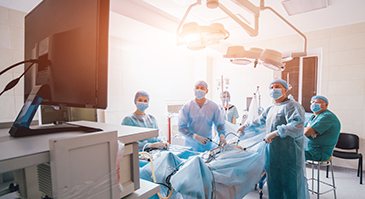
Laparoscopy is performed under general anesthesia. Thanks to this, complete relaxation of smooth muscles is achieved.
Laparoscopy
This method is considered the most accurate among all aimed at studying the patency of the fallopian tubes. Laparoscopy is performed under general anesthesia. Thanks to this, complete relaxation of smooth muscles is achieved. The doctor can detect all adhesions and foci of endometriosis. It should be understood that laparoscopy is a full-fledged surgical intervention. The need for it arises quite rarely.
How to check the patency of the fallopian tubes in a woman in a specific case? The gynecologist will answer this question after examining and examining the patient.
results

During the HSG procedure of the fallopian tubes, polyps and fibroids are detected. These pathologies are manifested by curvature of the contour, expansion of the uterus, and partial filling of the cavity.
When receiving images during hysterosalpingography, the doctor carefully analyzes them, identifying various pathological conditions. For example, if the fallopian tubes are obstructed, the contrast agent stops at a certain section due to adhesions and does not enter the abdominal cavity.
The contrast also allows you to study the shape of the uterus. Normally, it is completely stained with the substance.
During the HSG procedure of the fallopian tubes, polyps and fibroids are detected. These pathologies are manifested by curvature of the contour, expansion of the uterus, and partial filling of the cavity.
Important! Only a doctor can make an accurate diagnosis based on the results of the examination.
Pertrubation
This diagnostic method involves the use of a special device with which carbon dioxide is supplied under pressure into the fallopian tubes.
The diagnosis is made based on data from a device that records the pressure inside the pipes. The degree of patency is assessed in the presence of indirect signs - if the patency is normal, then during the procedure a characteristic noise occurs in the abdominal space.
There are a number of contraindications:
- increased content of leukocytes in the blood;
- bloody discharge from the uterus;
- infectious processes.
The procedure can be potentially dangerous, but only if the doctor does not follow the rules of the examination.
Advantages of contacting MEDSI
- Experienced doctors.
The clinic’s gynecologists regularly improve their skills and have the necessary skills and knowledge not only for diagnosis, but also for further elimination of detected pathological conditions and diseases. Specialists understand all the intricacies of female reproductive health, can quickly make an accurate diagnosis and prescribe adequate treatment - Comfort of visiting the clinic.
We ensured there were no queues. It is also important that the clinic is located near a metro station. This is convenient both for residents of the capital and for those who come to MEDSI from other localities for examination and further in vitro fertilization - Maximum painlessness of the procedure.
HSG is performed using a special catheter. It does not cause significant discomfort to the patient - Modern expert class equipment.
It allows examinations to be carried out with minimal radiation exposure and minimal discomfort, as well as accurate results. Thanks to this, patients are not exposed to any risks - Quality and accessibility of the examination.
We not only provide high diagnostic accuracy, but also adhere to a loyal pricing policy
To sign up for hysterosalpingography (HSG) of the fallopian tubes in Moscow, to find out the cost of diagnostics, just call us at . The specialist will select the optimal time to visit the clinic. You can also make an appointment using the SmartMed app.
Specialized centers
Reproductive Health Center
- Experienced specialists in the field of reproductive health
- Wide range of medical services
- Laboratory of Assisted Reproductive Technologies (ART)
More details
Are there any signs of this problem?
This pathology is insidious in that many women do not feel any symptoms at all indicating this problem. Some deliberately use contraceptive methods, and when they have a desire to become a mother, then long months of active sexual activity do not produce any results. And only with the help of research is it possible to find out about obstruction of the pipes.
You can suspect this problem if you have the following symptoms:
- Inability to become pregnant for a sufficiently long period of time (more than 6-12 months) with an active sexual life with a partner.
- Pain in the lower abdomen. Pain sensations can be of different intensity and nature: dull, sharp pulsating, etc. This is a clear sign of an inflammatory process.
- Pain in the groin during sex, when bending or turning.
- Irregular menstruation with heavy discharge.
- Enlargement of pipes, which becomes noticeable to the naked eye.
With this pathology, there is a risk of an ectopic pregnancy, which is characterized by quite vivid symptoms: severe pain, heavy bleeding from the vagina, increased body temperature, problems with urination.



